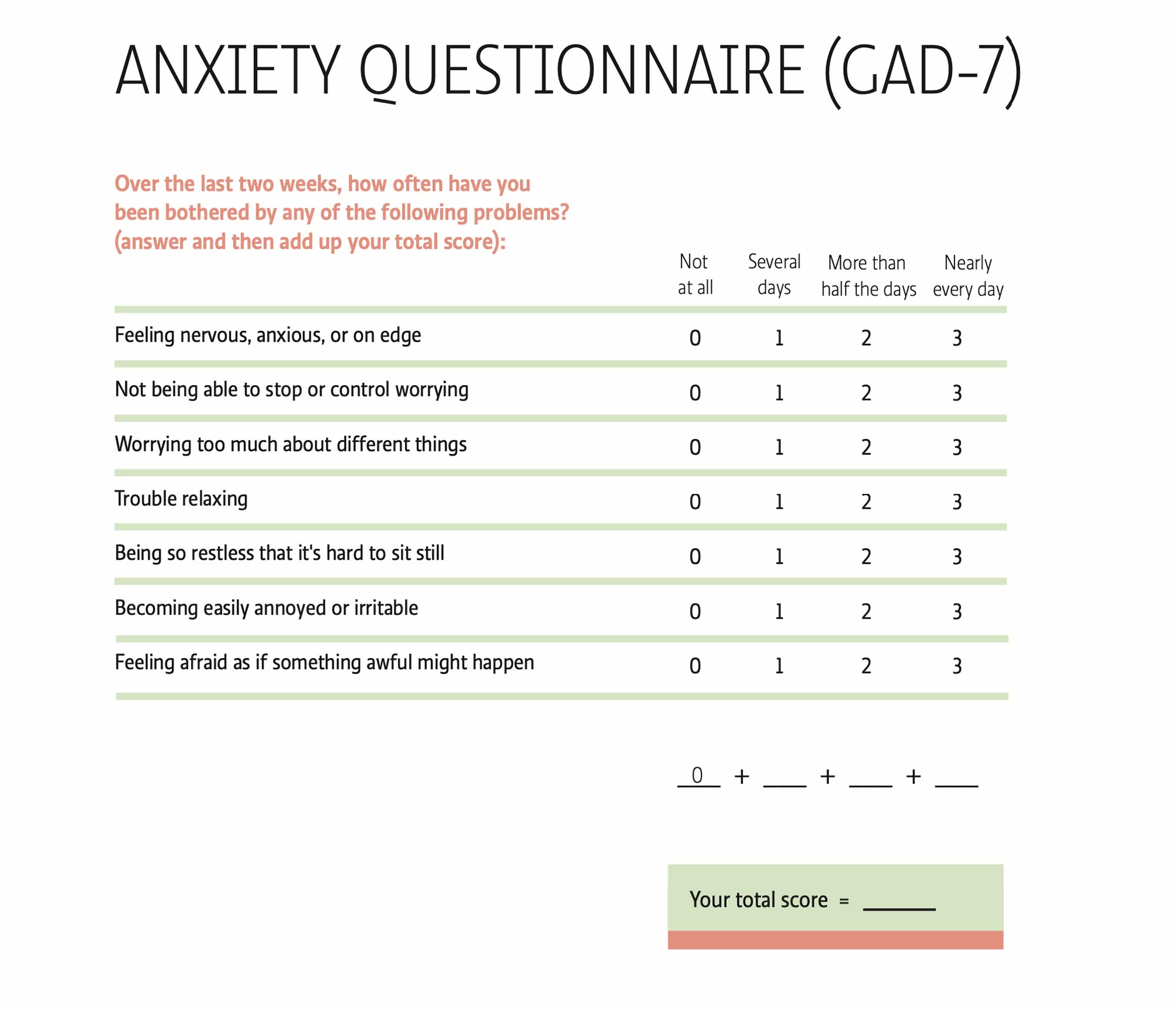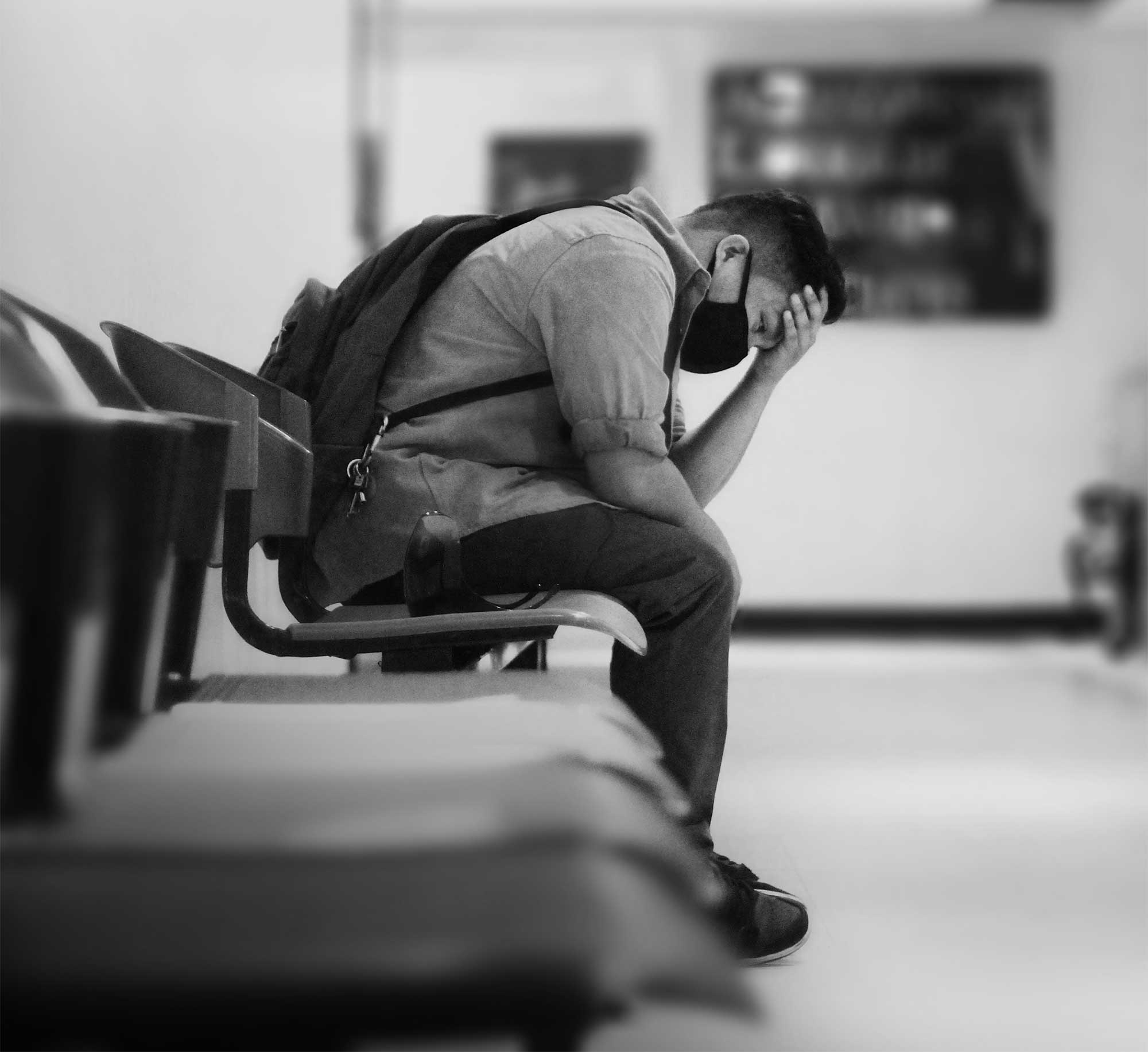
ANXIETY
If worries are wearing you down, there is hope.
ANXIETY
If worries are wearing you down, there is hope.
WRITERS’ NOTE
Anxiety hit me as a teenager. I worried about grades, relationships, and a million things. But most of all, I was terrified that I wasn’t good enough for God.
Worrying left me exhausted and in a lot of pain, so I went to doctor after doctor asking for tests to find out if I was physically sick.
But the tests were always negative. I didn’t know what anxiety was, so I didn’t ask the doctors for help.
All through college, I struggled. I couldn’t understand how other peo- ple had energy to spare.
Then in my first job after school, I met Gary Parks, and he was just so…happy.
He wasn’t afraid of what other people thought.
He wasn’t crushed under a load of guilt. And he seemed safe – someone I could talk to.
One day, when I felt like I’d hit rock bottom, I got on the phone and asked Gary for help.
He said yes.
After a medical workup, he sat with me as I learned to confront my anxious thoughts.
And as a pastor, Gary helped me realise that God loved and accepted me the way I am.
Thanks to one safe person, I was finally able to heal. And you can too, I am sure of it.
The weight, the pain– you don’t have to live like this. God wants you, and me, to be free.
-Rachel

No Condemnation:Spotting The Lies

What’s the difference between God’s calling and anxious guilt?
God will never condemn you.

Anxiety isn’t easy for anyone to battle, and for those of us who grew up with a religious background, it can get a little extra complicated. See, anxiety disorders can create irrational feelings of guilt. And sometimes, those of us who follow Jesus think any guilt at all must be a message from God.
That’s where the problem happens. Anxiety creates guilt for no reason; we believe God must be sending us that guilt; and then anxiety and religion get all tangled up in a messy downward spiral of confusion.
The more anxious we feel, the more we worry that we aren’t good enough for God. We try harder to be good enough, but that makes us worry more. And the more anxious we become, the guiltier we feel.
Finally, if the spiral goes unchecked, we can end up cutting more and more things out of our lives until there’s nothing we can do, and nothing we can eat, drink, or think about that doesn’t make us feel guilty. But we don’t feel better. We feel even worse.
So now what? How can we separate our own anxious feelings from God’s promptings on our hearts? Here’s a thought that might help as we each learn to listen for God’s gentle voice:

God calls us toward things, while anxiety condemns us. When the Pharisees brought Jesus a woman caught in adultery, she probably felt guilty. And she had a reason. She’d broken Jewish law, and she knew that according to the rules of her time, she wouldn’t live much longer.
But after Jesus chased the hypocrite Pharisees away, he turned to the guilty woman and asked her a question:”Woman, where are they? Has no one condemned you?” “No one, sir,” she said. “Then neither do I condemn you,” Jesus declared. “Go now and leave your life of sin” (John 8:10-11, NIV).
“Anxiety does not empty tomorrow of its sorrows, but only empties today of its strength.” -Charles Spurgeon

Jesus didn’t ask the woman if she felt guilty. That wasn’t his goal. He knew she’d made a mistake, just like everyone else on earth, but he didn’t spend his time telling her how wrong she was, or looking down on her. He simply pointed her in the direction of a happier and more fulfilling life and said: “Go.”
Jesus is a healer, not a prosecutor. Romans 8:1-2 says “there is now no condemnation for those who are in Christ Jesus, because through Christ Jesus the law of the Spirit who gives life has set you free from the law of sin and death” (NIV).
The Bible is clear that Jesus wants to heal us. He wants us to be whole. But our God doesn’t condemn us. He calls us toward things – gives us steps we can reach.
ANXIETY QUESTIONNAIRE

SCORING – Doctors use this seven-question test to measure several different anxiety disorders.
What does your score mean?. Use the categories below to score your results and get a better idea of how anxiety is impacting your life.
Keep in mind, though, that while this questionnaire is a great tool for monitoring your symptoms, it doesn’t replace a diagnosis from a doctor or mental health professional. Show your completed questionnaire to your doctor so she or he can help you best understand your results.
Your doctor can also help rule out other medical conditions that might be causing your symptoms before diagnosing you with an anxiety disorder. And no matter your score, pay attention to how you answered the bonus question. If anxiety is heavily impacting your life, treatment can help.
After you read up, be sure to bring your full questionnaire to your doctor or therapist. He or she will look at your answers individually and make a treatment plan.

0-4: No anxiety disorder
If you scored less than five on this questionnaire, then we have good news. Your anxiety is probably in the normal range. You probably feel anxious sometimes, since anxiety is a normal part of life, but you most likely don’t have an anxiety disorder. If you’re feeling more stressed than you’d like, though, the tips in this booklet series can still help you to manage your daily stresses and feel more relaxed. If your score doesn’t seem right to you, though, listen to your gut. Make an appointment with your doctor to discuss your specific situation
5-9: Mild anxiety disorder
A score in this range means your anxiety is mild, from a clinical perspective, but it’s still weighing you down. You go through your day with all kinds of extra worries and fears. It might seem like there’s no way to avoid those anxious thoughts, but don’t give up hope. You can learn to manage your anxiety. Make sure your doctor knows how you’re feeling so that he or she can monitor your condition. Plus, follow the tips in these booklets, especially issues 5-7, for advice on managing your symptoms. Hang in there!

10-14: moderate anxiety disorder
With a score in this range (or as low as 8 for people with panic disorders, social anxiety, or PTSD), anxiety is probably affecting you every day.
It’s chasing you, filling your head with worries, and interfering when you’re trying to live your life. Some people may not understand the cloud of worries that you’re fighting every day, but we see you. And we’re proud of you for reading this course– it’s a step to feeling better.
Make an appointment with your doctor to talk about the best treatment. She or he may recommend that you see a mental health professional. The advice in this course can help, too, along with your treatment, of course. Congratulations on starting to take back your life!

15 or more: Severe anxiety disorder
Worries and fears are like a wall, blocking you from the life you want to live. You’re spending so much energy dealing with those anxious thoughts that it leaves you exhausted all day long. You’re very brave for how long you’ve carried this with you, and even braver to pick up this booklet.
You are stronger than your anxiety – strong enough to reach out for treatment, and strong enough to take back your life. Follow the tips listed for moderate anxiety disorder above, and don’t give up if results take time. With treatment and patience, you can feel better..

Learning About Anxiety

Prepare to talk with a doctor or mental health professional by educating yourself on the risks and treatment options for anxiety disorders.
The following medical information is from the National Institute for Mental Health (NIMH) website, reprinted here with light editing for flow.

Occasional anxiety is an expected part of life.
You might feel anxious when faced with a problem at work, before taking a test, or before making an important decision. But anxiety disorders involve more than temporary worry or fear.
For a person with an anxiety disorder, the anxiety does not go away and can get worse over time. The symptoms can interfere with daily activities such as job per- formance, school work, and relationships.

Risk Factors
Researchers are finding that both genetic and environmental factors contribute to the risk of developing an anxiety disorder. Although the risk factors for each type of anxiety disorder can vary, some general risk factors for anxiety include:
• Temperamental traits of shyness or of behavioral inhibition in childhood
• Exposure to negative life or environmental events in early childhood or adulthood
• A history of anxiety or other mental illnesses in biological relatives.
Some physical health conditions, such as thyroid problems or heart arrhythmias, or caffeine or other substances/medications, can produce or aggravate anxiety symptoms; a physical health examination is helpful in the evaluation of a possible anxiety disorder.
Types of Anxiety Disorders
There are several types of anxiety disorders, includ- ing generalized anxiety disorder, panic disorder, and various phobia-related disorders.
Generalised Anxiety Disorder:People with generalized anxiety disorder, or GAD, display excessive anxiety or worry, most days for at least • six months, about various things such as personal health, work, social interactions, and • everyday routine life circumstances. The fear and • anxiety can cause significant problems in areas • of their life. GAD develops slowly. It often starts • during the teen years or young adulthood. •
People with GAD may: • Worry very much about everyday things • Have trouble controlling their worries •. Know they worry more than they should • •Be easily startled, tremble, or twitch • Have trouble falling asleep or staying asleep • Feel easily tired or tired all the time • Have headaches, muscle aches, stomach aches, or unexplained pains • Have a hard time swallowing • Be irritable or feel “on edge”• Sweat a lot• Feel light-headed or out of breath • Have to go to the bathroom a lot

Adults and Children Can Be Affected: Children and teens with GAD often worry exces- sively about: their performance, such as in school or sports; and catastrophes, such as earthquakes or war. Adults with GAD are often highly nervous about everyday circumstances such as: job security or performance, health and finances, being late, or chores and responsibilities.Both children and adults with GAD may experience physical symptoms that make it hard to function, and that interfere with daily life. Symptoms may get better or worse at different times, and they are often worse during times of stress, such as with a physical illness, during exams at school, or during a family or relationship conflict.
Panic Disorder: People with panic disorder have recurrent unexpected panic attacks. Panic attacks are sudden periods of intense fear that come on quickly and reach their peak within minutes. Attacks can occur unex- pectedly or can be brought on by a trigger, such as a feared object or situation.
During a panic attack, people may experience:
• Heart palpitations, a pounding heart- beat, or an accelerated heart rate
• Sweating
• Trembling or shaking
• Sensations of shortness of breath,
smothering, or choking
• Feelings of impending doom
• Feelings of being out of control
People with panic disorder often worry about when the next attack will happen and actively try to prevent future attacks by avoiding places, situations, or behaviors they associate with panic attacks. Both worry about panic attacks, and the effort spent trying to avoid attacks, cause significant problems in various areas of the person’s life, including the development of agoraphobia.

Phobia-related disorders:A phobia is an intense fear of—or aversion to—specific objects or situations.
Although it can be real- istic to be anxious in some circumstances, the fear people with phobias feel is out of proportion to the actual danger caused by the situation or object.
People with phobias often do quite well in life except when confronted by this situation or object. Some examples include flying, heights, snakes, or injections.

Learning About Anxiety

Social anxiety disorder is a common type of anxiety disorder. A person with social anxiety disorder feels symptoms of anxiety or fear in certain or all social situations, such as meeting new people, dating, being on a job interview, answering a question in class, or having to talk to a cashier in a store.
Doing everyday things in front of people—such as eating or drinking in front of others or using a public restroom—also causes anxiety or fear. The person is afraid that he or she will be humiliated, judged, and rejected.
The fear that people with social anxiety disorder have in social situations is so strong that they feel it is beyond their ability to control. It gets in the way of going to work, attending school, or doing everyday things.
People with social anxiety disorder may worry about things for weeks before they happen. Sometimes, they end up staying away from places where they think they might have to do something that will embarrass them.
When having to perform in front of or be around others, people with social anxiety disorder tend to:
• Blush, sweat, tremble, feel a rapid heart rate, or feel their “mind going blank”
• Feel nauseous or sick to their stomach
• Show a rigid body posture, make little eye contact, or speak with an overly soft voice
• Find it scary and difficult to be with other people, especially those they don’t already know, and have a hard time talking to them even though they wish they could.
• Be very self-conscious in front of peo- ple and feel embarrassed and awkward
• Be afraid other people will judge them
• Stay away from places where there are other people


Agoraphobia:
People with agoraphobia have an intense fear of two or more of the following situations:
• Using public transportation
• Being in open spaces
• Being in enclosed spaces
• Standing in line or being in a crowd
• Being outside of the home alone
People with agoraphobia often avoid these situations, in part, because they think being able to leave might be difficult or impossible if they have panic-like reactions or other embar- rassing symptoms. In the most severe form of agoraphobia, people can become housebound.

Separation anxiety disorder:
Separation anxiety is not something that only children deal with. Adults can also be diagnosed with separation anxiety disorder.
People who have separation anxiety disorder have fears about being parted from people to whom they are attached. They often worry that something will happen to their attachment figures while they are separated.
This fear leads them to avoid being separated from their attachment figures and to avoid being alone. People with separation anxiety may have nightmares about being separated from attachment figures or experience phys- ical symptoms when separation happens or is about to occur.

Treatment for Anxiety
The good news is that anxiety is treatable. Talk to your doctor about your symptoms. Your doctor should do an exam and ask you about your health history to make sure that a physical problem is not causing your symptoms. Your doctor may refer you to a mental health specialist.
Anxiety disorders are generally treated with psychotherapy, medication, or both. Don’t give up on treatment too quickly. Both psychotherapy and medication can take time to work. A healthy lifestyle and stress management techniques and meditation can also help people with anxiety disorders.

Support groups
Some people with anxiety disorders might benefit from join- ing a self-help or support group. Talking with a trusted friend or member of the clergy can also provide support, but it is not necessarily a sufficient alternative to care from a doctor or other health professional.
Take care of yourself
A healthy lifestyle can help combat anxiety. Make sure to get enough sleep and exercise, eat a healthy diet, and turn to family and friends you trust for support.
Slow and steady wins the race:
Advice for managing anxiety
Healing doesn’t happen in a day
Learning to manage anxiety can be overwhelming, so don’t be afraid to break your goals up into small, achievable steps. Recovery isn’t a straight line; it’s a spiral. Setting one small goal and completing it is much better than overwhelming yourself and ending up more anxious than ever.
Kjetil Mellingenne is a specialist in cognitive behavioral therapy – a type of talk therapy that is often helpful for anxiety. On his YouTube channel, Mellingenne tells the story about one of his clients who, without warning, suddenly stopped coming in for her visits to his office.
Surprised that she missed her appointment, the psychologist got on the phone and learned that she was too afraid to leave her home. Fortunately, her therapist knew how to help. Could she go outside at all? he asked. Even for a minute? Yes, the client said. She thought she could make it to her front step for a few minutes. Then go outside, stay for a few minutes, and then go back in, the psychologist told her. But don’t rush yourself.
Do the same thing ten or fifteen times before you try to stay outside any longer. The client agreed, and after ten or fif- teen short trips to her front porch, she was ready to stay outside a little lon- ger and walk a bit farther. She reached her yard, then the front gate, repeat- ing each achievement at least ten times before she set a new goal. With time and patience, Mellingenne’s client was finally able to travel from her home to his office. She had conquered her fear.
Later, the psychologist explained that the reason he’d suggested such small steps was so his client could be sure she would succeed. If she had felt that one of his goals was too hard to reach, it might have made her anxiety stronger, and the
setback could have made it even harder for her to leave home.

